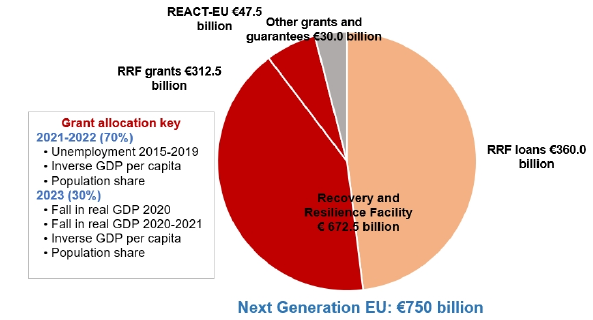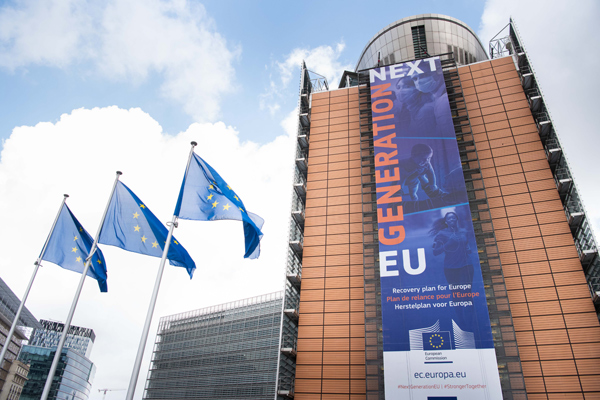Original version in Spanish: Las cifras para España del Plan de Recuperación Europeo.
Theme
The shape of the European Recovery Fund is becoming clearer. This analysis looks at the figures for Spain.
Summary
The European Recovery Fund, in combination with the other European initiatives to respond to the economic crisis caused by COVID-19, will see almost €2 trillion of investment in Europe over the coming years. Spain is set to receive around €200 billion of this sum, with around €150 billion coming from the Recovery Fund and over €80 billion in transfers. This paper examines these figures in detail.
Analysis
(1) Introduction
The COVID-19 pandemic has had a profound economic impact throughout Europe. Against a backdrop of extremely challenging circumstances and faced with fears of a collapse of the single market and the appearance of major divergences between northern and southern Member States, last summer the EU approved an unprecedented fiscal response to the crisis. At the heart of the response lies its most innovative element: the Next Generation EU (NGEU) programme, better known as the Recovery Fund. The programme complements the bold steps taken by the European Central Bank (ECB) to maintain liquidity and avert a sovereign debt crisis, new credit lines approved by the European Stability Mechanism and the European Investment Bank, the Support to mitigate Unemployment Risks in an Emergency (SURE) scheme by the European Commission, and the approval of the Multiannual Financial Framework (MFF) for 2021-27.
Taken together, these measures represent almost €2 trillion of investment in EU Member States over the coming years. Spain is set to receive around €200 billion of this sum, with around €150 billion coming from the Recovery Fund and over €80 billion in transfers. These funds will facilitate otherwise difficult investment and prevent Spanish public debt –which stood at 117% of GDP at the end of 2020– from escalating further. The Recovery Fund is also a major step on the long road towards the construction of a full and sustainable economic and monetary union, since it radically changes the way the EU finances its investment.
The European Commission will issue large amounts of common debt (up to €750 billion), backed by all the Member States and which will, in principle, be repaid by new sources of revenue at the European level, taking the form of European taxes, such as a plastic levy or tariffs on highly polluting products. If these funds are correctly used, in addition to transforming the European economy by making it more digital, green and inclusive, NGEU paves the way for more fiscal integration and a stronger role for the euro in the international monetary system.
More than six months after the fund was established, we are starting to build up a clearer picture of its workings and governance, as well as the dates and conditions for the disbursement of funds. This article analyses the figures currently in the public domain.
(2) Understanding the numbers
Their sheer scale aside, anyone who has looked at the figures of the European response to the pandemic will have realised how difficult it is to understand their distribution, both in terms of countries and in terms of programmes or administrative levels. Beyond the labels ‘green’, ‘digital’ and ‘inclusive’ and the much-repeated price tag of €750 billion, there remains considerable confusion, as well as many loose ends to be tied up. This section attempts to understand these figures and clear up some misconceptions.
The final distribution of the €750 billion for NGEU, expressed in 2018 constant prices, is split along the following lines:
- €672,500 million for the Recovery and Resilience Facility (RRF), which will finance reforms and projects for the green and digital transition.
- €47,500 million for the Recovery Assistance for Cohesion and the Territories of Europe (REACT-EU) programme, which expands on the Coronavirus Response Investment Initiatives (CRII and CRII+, adopted in April 2022 in response to the COVID-19 crisis to allow more flexible access to the EU budget) and provides bridging finance between the short-term requirements to address the challenges created by the pandemic and the long-term transformation.1
- €30,000 million for other funds, including €7,500 million for rural development (under the second pillar of the Common Agricultural Policy), €10,000 million for the Just Transition Fund (to cover the social and economic cost of reducing emissions), €5,600 million for InvestEU guarantees, €1,900 million for rescEU (civil protection and humanitarian aid) and €5,000 million for research as part of the Horizon programme.
In total, there will be €390,000 million in transfers (including guarantees) and €360,000 million in loans (Figure 1).Figure 1. Distribution of Next Generation EU (€ billion, 2018 constant prices)
| Item | Value € billion |
|---|---|
| Next Generation EU | 750.0 |
| Recovery and resilience mechanism | 672.5 |
| (loans) | 360.0 |
| (grants | 312.5 |
| REACT-EU | 47.5 |
| Other funds | 30.0 |
| Horizon Europe | 5.0 |
| InvestEU | 5.6 |
| Rural Development (Common Agricultural Policy pillar 2) | 7.5 |
| Just Transition Fund | 10.0 |
| rescEU | 1.9 |
Source: European Commission.
The €672,500 million of the RRF (the main component of NGEU) includes €312,500 million of grants to be distributed in two phases: a first tranche of 70% earmarked for 2021-22, based on economic indicators in the run up to the pandemic (unemployment between 2015-19, GDP per capita and population) and the remaining 30% planned for distribution in 2022 for 2023-24, depending on the subsequent evolution of the economy (change in GDP in 2020 and 2021, GDP per capita and population).
The remaining €360,000 million will take the form of loans, which must be expressly requested by the Member States, with an upper limit of 6.8% of gross national income.

As noted, all these figures are expressed in 2018 constant prices. In current prices, the total firepower of NGEU is €807,000 million, including €724,000 million for the RRF (with €338,000 million of grants and €386,000 million of loans).2
(3) The figures for Spain
Spain has access to three types of European funds over the coming years (expressed in current prices):
- First, the new funds to finance physical and human capital, including €154,996 million from NGEU and €43,813 million from the MFF 2021-27 (excluding the European Agricultural Guarantee Fund, since these funds will be used to support incomes and prices, as explained below).
- Secondly, the reprogramming of existing funds, both to finance physical and human capital and to alleviate the short-term crisis. This comprises €36,839 million of unspent allocation from the MFF 2014-20, which has been channelled through the extraordinary CRII and CRII+ mechanisms to provide liquidity for autonomous communities for 2020-21 (with considerable flexibility and without the need for co-financing).
- Finally, the new funds for supporting incomes and prices, which include €39,193 million from the European Agricultural Guarantee Fund (EAGF), as part of the MFF 2021-27 (€37,412 million in direct payments and €1,781 million in market mechanisms, to support agricultural incomes and prices) and €21,300 million in loans from the SURE income support scheme (to support labour income).
The latest calculations show that Spain will be one of the largest recipients of NGEU funds, receiving a total of €154,996 million. As one of the biggest countries in the EU and having experienced one of the sharpest falls in GDP in 2020, Spain will receive around €141,128 million from the RRF for 2021-26, including €69,528 million in transfers (with the possibility for adjustments to the last 30%) and around €71,500 million in loans. The country will also receive €132,800 million from REACT-EU for 2021-22, €339 million from the Just Transition Fund included in this instrument and €729 million from the EAFRD for rural development (Figure 3).Figure 3. Estimate of EU funds for Spain 2021–27 (current prices)
| Item | € million | Committed before | Spending horizon |
|---|---|---|---|
| NGEU | 154,996 | ||
| REACT-EU | 12,800 | 2020-2021 | End of 2022 |
| RRF, grants | 69,528 | ||
| First tranche (70%) | 46,603 | 2021-2022 | End of 2024 |
| Second tranche (30%) (1) | 22,925 | 2022-2023 | End of 2026 |
| RRF, loans (1) | 71,600 | 2021-2026 | No aplicable |
| Just Transition Fund (2) | 339 | 2021-2023 | End of 2026 |
| EAFRD (rural development) | 729 | 2021-2023 | End of 2026 |
| MFF 2021-2027 (except EAGF) | 43,813 | 2021-2027 | End of 2030 |
| European Social Fund | 11,153 | 2021-2027 | End of 2030 |
| ERDF (rural development) | 23,540 | 2021-2027 | End of 2030 |
| Cohesion (ETC) | 683 | 2021-2027 | End of 2030 |
| EAFRD | 7,802 | 2021-2027 | End of 2030 |
| Just Transition Fund | 451 | ||
| Brexit Adjustment Reserve (tranche 1) (3) | 184 | ||
| TOTAL NGEU + MFF (except EAFG) | 198,809 | ||
| Pro memoria: | |||
| Remaining balance MFF 2014-2020 | 36,839 | ||
| EAGF 2021-2027 | 39,193 | ||
| Direct payments | 37,412 | ||
| Other payments (1) | 1,781 | ||
| SURE | 21,300 |
Notes: (1) estimate; (2) the Just Transition Fund totals €790 million, comprising €339 million from NGEU and the remaining €451 million from the MFF 2021-27; and (3) Brexit Adjustment Reserve (included here under the MFF, although legally outside the budget) is split into two tranches (Spain will receive €184 million of the first tranche of 80%).
Source: the authors.
The Spanish share of the multiannual financial framework for 2021-27 (excluding the EAGF) includes €11,153 million from the European Social Fund, €23,450 million from the European Regional Development Fund (ERDF), €7,802 million from the EAFRD (EAFRD), €683 million from European Territorial Corporation (ETC or better known as Interreg) and €451 million from the MFF Just Transition Fund (making the total for this fund for Spain €790 million). This is also complemented by the Brexit Adjustment Reserve (outside the budget), with Spain set to receive around €184 million of the first 80% of these funds.
Taken together, NGEU and the funds from the MFF 2021-27 make up €198,809 million of new financing for physical and human capital.
Furthermore, as mentioned above, Spain has also been able to reprogramme existing funding. As of 2020, Spain had yet to spend around €376,839 million of its allocation of €56.491 million from the MFF 2014-20 (whose funds can be spent until 2023). The extraordinary CRII and CRII+ mechanisms have provided extra flexibility for the use of these funds (without a co-financing requirement) to finance health spending, employment support schemes and to provide liquidity for small and medium enterprises, retroactively to 1 February 2020.
Finally, we must not forget European funds to support incomes (or prices), both agricultural and in the broader labour market. These comprise €39,193 million from the EAGF under the MFF 2021-27 and €21,300 million in loans from the SURE programme, allocated to Spain to finance its employment support scheme.
Taken together, these funds should allow Spain to meet its most urgent needs and undertake an ambitious investment programme to reduce the impact of the recession and increase the potential for growth.
Not all these funds will be automatically disbursed. Instead, they will be conditional on Spain –like other EU Member States– submitting a National Recovery and Resilience Plan by 30 April 2021 for approval by the European Commission. The plan must include a detailed analysis of reforms and investments, as well as a schedule, and must be aligned with EU priorities. Under this general framework, the Government of Spain publicly unveiled its España Puede plan on 7 October 2020, outlining its future Recovery and Resilience Plan. The governing principles of this plan are closely aligned with the general objectives of NGEU (digitalisation, sustainability and inclusion), in addition to a further objective on gender equality.
Since then, the Spanish authorities have been working to define potential guidelines for projects, as well as the reforms and instruments needed to avoid delays in making the funds available. On 22 December 2020 the Government approved a Royal Decree-Law streamlining the administrative procedures for the selection, award, implementation and control of projects, and setting out the key governance mechanisms for funds. The Royal Decree-Law was ratified by the parliament on 28 January 2021.
The Spanish plan, which is among the most advanced of all Member States –with 10 policy priorities, broken down into 30 lines of action– is expected to be approved before the April deadline.
(4) European funds in the Spanish Budget for 2021
Regardless, Spain faces an enormous challenge: for 2021 alone, the Government has included €26,634 million of NGEU funds (€24,200 million from the RRF and €2,436 million from REACT-EU) in its budget. These investments are parts of the State budget allocated against EU funds whose implementation has already begun and which will be financed by issuing Spanish debt (at an extremely low financing cost, thanks to the ECB) in anticipation of the NGEU investment, which will start to arrive in the second half of 2021. Even though the implementation of these funds is simpler than the European cohesion ones (there is no co-financing requirement), it is nonetheless still a formidable sum.Figure 4. Spanish State Budget for 2021: spending financed by EU funds
| Sections | €million | % |
|---|---|---|
| Ministry for Foreign Affairs, European Union and Cooperation | 127.6 | 0.5 |
| Ministry of Justice | 27.7 | 0.1 |
| Ministry of Defence | 25 | 0.1 |
| Ministry of the Interior | 6.3 | 0 |
| Ministry of Transport, Mobility and Urban Agenda | 4,982.40 | 18.7 |
| Ministry of Education and Vocational Training | 1,852.60 | 7 |
| Ministry of Labour and Social Economy | 1,167.50 | 4.4 |
| Ministry of Industry, Trade and Tourism | 1,708.00 | 6.4 |
| Ministry of Agriculture, Fisheries and Food | 406.5 | 1.5 |
| Ministry of Territorial Policy and Civil Service | 239.9 | 0.9 |
| Ministry for the Ecological Transition and the Demographic Challenge | 6,805.20 | 25.6 |
| Ministry of Culture and Sport | 206.3 | 0.8 |
| Ministry of Health | 2,944.00 | 11.1 |
| Resilience and Recovery Mechanism | 508 | 1.9 |
| REACT-EU | 2,436.00 | 9.1 |
| Ministry of Economic Affairs and Digital Transformation | 3,653.70 | 13.7 |
| Ministry of Science and Innovation | 1,101.70 | 4.1 |
| Ministry of Social Rights and 2030 Agenda | 916.9 | 3.4 |
| Ministry of Equality | 48.6 | 0.2 |
| Ministry of Inclusion, Social Security and Migration | 183.7 | 0.7 |
| Ministry of Universities | 203.9 | 0.8 |
| Social Security | 27 | 0.1 |
| Total RRF + REACT-EU | 26,634.00 | 100.0 |
| (RRF) | 24,198.00 | 90.9 |
Source: Spanish State budget for 2021.
The Ministry for the Ecological Transition and the Demographic Challenge will receive more than 25% of the funds, followed by the Ministry of Transport (19%) and the Ministry of Economic Affairs and Digital Transformation (14%). In total, there is over €17,200 million for the green and digital economic transformation and almost €9,000 million for social spending (health, education, employment, culture and social policies).
Of the €26,634 million of European funds in the State budget for 2021, €10,793 million will be transferred to the autonomous communities and €1,483 million to local authorities for the areas in which they have powers. Industry and energy, health, education, resilient infrastructure and ecosystems, and access to housing and promoting construction make up 80% of these areas.Figure 5. Transfers of EU funds to autonomous communities and local authorities in the State Budget for 2021 (€ million)
| Policy area | Autonomous communities | % | Local authorities | % | Total | % |
|---|---|---|---|---|---|---|
| Industry and Energy | 2.663 | 24,7 | 0 | 0,0 | 2.663 | 21,7 |
| Health (1) | 1.821 | 16,9 | 0 | 0,0 | 1.821 | 14,8 |
| Education | 1.685 | 15,6 | 3 | 0,2 | 1.689 | 13,8 |
| Resilient infrastructure and ecosystems | 1.152 | 10,7 | 513 | 34,6 | 1.664 | 13,6 |
| Access to housing and promoting construction | 1.580 | 14,6 | 50 | 3,4 | 1.630 | 13,3 |
| Social services and promotion | 942 | 8,7 | 15 | 1,0 | 956 | 7,8 |
| Trade, tourism and SMEs | 150 | 1,4 | 782 | 52,7 | 932 | 7,6 |
| R&D&I and digitalisation | 504 | 4,7 | 15 | 1,0 | 519 | 4,2 |
| General services | 136 | 1,3 | 92 | 6,2 | 228 | 1,9 |
| Agriculture, fisheries and food | 115 | 1,1 | 0 | 0,0 | 115 | 0,9 |
| Job creation | 12 | 0,1 | 12 | 0,8 | 25 | 0,2 |
| Other economic measures | 23 | 0,2 | 2 | 0,1 | 25 | 0,2 |
| Culture | 11 | 0,1 | 0 | 0,0 | 11 | 0,1 |
| Justice | 0 | 0,0 | 0 | 0,0 | 0 | 0,0 |
| Total | 10.793 | 100,0 | 1.483 | 100,0 | 12.277 | 100,0 |
(1) Includes €408.5 million from REACT-EU. Source: Spanish State budget for 2021.
Conclusions
Spain faces a formidable challenge. Never before has it benefited from such a large amount of funds in such a short space of time. Yet it must find a way to implement reforms and projects in a highly polarised political environment, without yet having overcome the pandemic and with the northern European countries –traditionally the Member States most reluctant to embrace this level of European financial solidarity– watching to see how well (or poorly) resources are used in the countries of the south. It should be noted that the RRF funding is conditional on the approval of the National Recovery and Resilience Plan, which must include the structural reforms from the European Semester for 2019 and 2020 and for which we have much less information than the projects to be financed. Nonetheless, it is crucial we see these reforms for what they really are: an essential step to put Spain on a path of sustainable growth and for which European funds are the perfect vehicle. Furthermore, if the funds help to transform the Spanish economy and prevent economic divergence between the north and south of Europe, they could become –albeit subject to certain modifications– a permanent feature of the much-needed European fiscal union. However, if their main recipients fail to rise to the challenge, it will be hard to convince the other Member States to take steps towards further integration.
Enrique Feás
Senior Research Fellow, Elcano Royal Institute, and State Economist and Trade Expert (Técnico Comercial y Economista del Estado) | @EnriqueFeas
Federico Steinberg
Senior Analyst, Elcano Royal Institute, and Lecturer in Political Economy at Madrid’s Universidad Autónoma | @steinbergf
1 REACT-EU reinforces the MFF with additional funds distributed through the European Regional Development Fund, the European Social Fund and the Fund for European Aid to the Most Deprived, in line with the economic and social impact of the pandemic.
2 Figures for the MFFs are often expressed in euros indexed to the base year, in this case 2018. They are translated into their current value by updating cash flows at 2%, in line with article 6.2 of Council Regulation No 1311/2013 of 2 December 2013.




